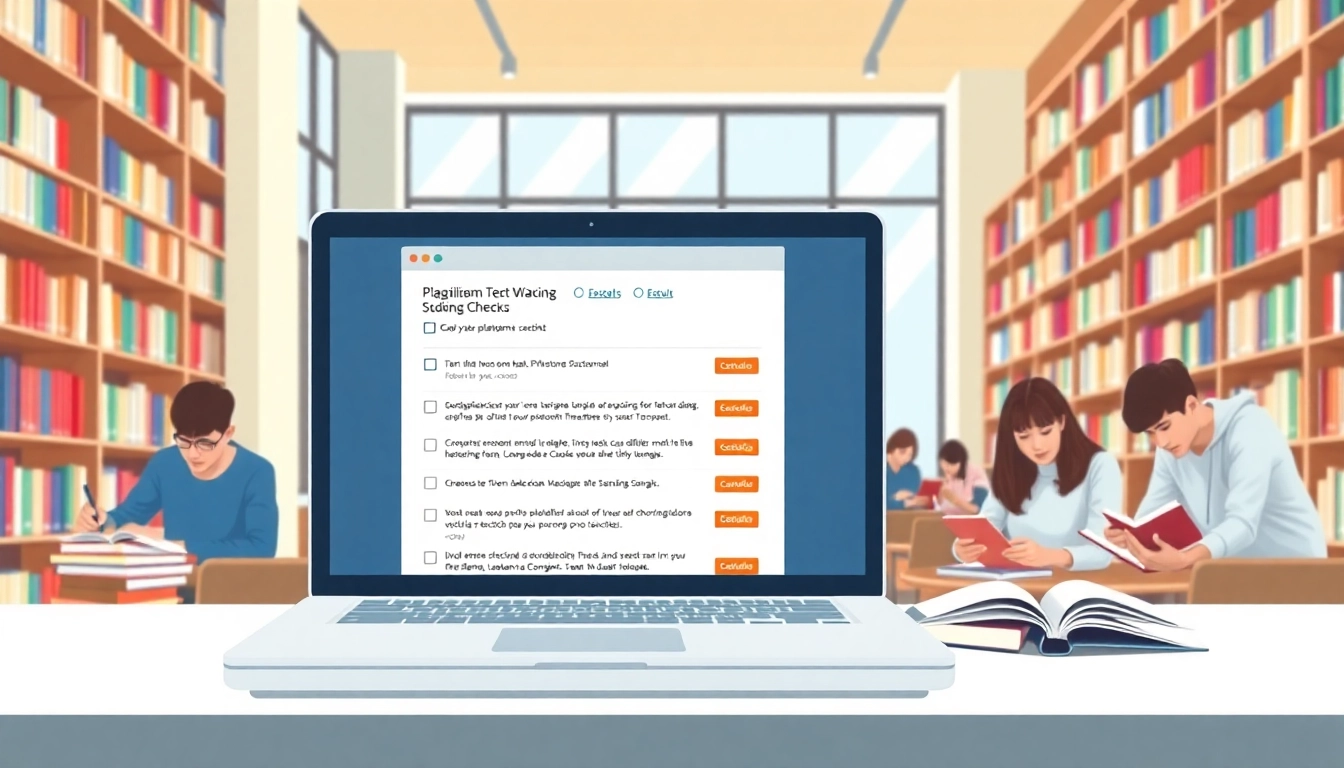Understanding Plagiarism Detectors
What is a Plagiarism Detector?
A plagiarism detector is an advanced software tool designed to identify instances of copied or similar content within written texts. By scanning submitted documents against vast databases of published works, online content, and academic papers, these tools help writers ensure originality and maintain academic integrity. In fields where originality is paramount, such as education, research, and content creation, using a plagiarism detector has become a standard practice. This technology not only highlights similarities but also provides percentage ratings of originality, allowing writers to gauge the uniqueness of their work.
How Plagiarism Detectors Work
Plagiarism detectors employ various technological methodologies to assess text for potential plagiarism. The process generally involves the following steps:
- Text Input: Users paste their text into the software interface or upload a document file.
- Database Comparison: The software performs a thorough comparison against a vast database that may include published academic papers, articles, websites, and more.
- Algorithm Analysis: Advanced algorithms analyze the text to identify matches, including paraphrases, direct quotes, and similar phrases. Some detectors utilize artificial intelligence to enhance accuracy by understanding context and writing style.
- Report Generation: Once the analysis is complete, the tool generates a report showing instances of potential plagiarism, highlighting matched text, and providing links to original sources for verification.
This process enables users to refine their content before submission, ensuring it meets originality standards and academic honesty guidelines.
Types of Plagiarism Detectors Available
Plagiarism detectors come in various forms, catering to different needs and user bases. The main types include:
- Free Online Checkers: Tools like DupliChecker and Plagiarism Checker Free offer basic functionality, typically allowing limited word count checks at no cost. Ideal for students or casual users.
- Paid Services: Comprehensive tools such as Turnitin, Grammarly, and Copyleaks provide in-depth analysis, real-time feedback, and additional features like grammar checking and formatting assistance.
- Institutional Software: Many educational institutions, colleges, and universities utilize customized plagiarism detection software integrated into their learning management systems, helping maintain academic standards across their programs.
Understanding the variety of available options enables individuals and institutions to choose a detector that best aligns with their specific needs and budget.
Key Features to Look for in a Plagiarism Detector
User-friendly Interface and Accessibility
An effective plagiarism detector should have an intuitive interface that users can navigate easily. This is particularly essential for students or those who may not be tech-savvy. Tools that allow for quick document uploads, easy text input, and clear navigation through results enhance the user experience. Accessibility across various devices, including smartphones and tablets, also plays a critical role in ensuring wider usage.
Comprehensive Database Coverage
The accuracy of a plagiarism detector largely depends on its database size and relevance. A comprehensive database that includes academic journals, books, articles, and web pages boosts the chances of catching potential plagiarism. Some advanced tools even have partnerships with educational institutions, extending their databases to cover a wider range of published works, which is especially beneficial for academic settings.
Real-time Results and Reporting
Fast and accurate results are crucial. A quality plagiarism detector should provide real-time feedback upon text submission or at least within a reasonable timeframe. Additionally, detailed reporting features that present findings in an easy-to-understand format, including highlighted text and source links, enhance usability and provide context for users. Some systems also offer suggestions for paraphrasing and citation, which can significantly aid users in refining their work.
Benefits of Using a Plagiarism Detector
Enhancing Academic Integrity
One of the primary benefits of using a plagiarism detector is maintaining academic integrity. In academic environments where originality is emphasized, using these tools can prevent inadvertent plagiarism. It empowers students to understand the boundaries of proper paraphrasing, quoting sources correctly, and developing original ideas without unintentional copying.
Improving Writing Skills
Regular use of plagiarism detectors not only helps maintain originality but also contributes to improving writing skills. As users receive feedback about their text, they can learn to identify areas that require better citation practices or more original phrasing. Over time, this feedback loop enhances both awareness and proficiency in writing.
Saving Time and Reducing Stress
For writers—whether students, academics, or professionals—ensuring originality can often lead to stress and fatigue. A plagiarism detector mitigates this by providing a quick assessment of content, allowing users to address any issues before submission. This can save valuable time that would otherwise be spent on extensive revisions, and ultimately leads to a more streamlined and efficient writing process.
Popular Plagiarism Detectors Reviewed
Free Plagiarism Detectors
Numerous free plagiarism detectors cater to casual users. Tools like:
- DupliChecker: Offers a user-friendly interface and allows users to check text snippets effortlessly. Ideal for students looking to ensure their homework is original.
- PapersOwl: An excellent option that supports various file formats and provides accurate plagiarism reports for free.
- Plagscan: Another viable free option, particularly popular among students, providing useful feedback on originality alongside plagiarism reports.
However, users should be cautious when relying solely on free services, as the depth of analysis and reporting may be limited compared to premium options.
Paid Options with Advanced Features
For more rigorous plagiarism checking and advanced features, paid options like Turnitin, Grammarly, and Copyleaks are favored. Each of these tools comes with unique benefits:
- Turnitin: Widely adopted in educational institutions, Turnitin not only checks for plagiarism but also aids instructors in assessing student originality and submissions.
- Grammarly: Known primarily for its grammar-checking capabilities, Grammarly also includes a plagiarism detection feature that scans texts against billions of web pages and academic resources.
- Copyleaks: Using AI, Copyleaks detects text similarity while also addressing issues of content ownership and code originality, expanding its utility beyond just written texts.
These options are generally more reliable and comprehensive, making them the preferred choice for those serious about content originality.
Comparative Analysis of Top Tools
When selecting a plagiarism detector, it is beneficial to perform a comparative analysis of the top tools available. A comparison might include criteria such as:
- Database size and depth
- Speed of results
- User experience and interface design
- Additional features (e.g., grammar checking, citation features)
- Subscription cost and pricing models
This assessment enables users to find a tool that best fits their requirements, ensuring they invest wisely in the software that meets their needs.
How to Choose the Right Plagiarism Detector for Your Needs
Assessing Your Specific Requirements
Before deciding on a plagiarism detector, assess your specific needs. Consider the following questions:
- Are you a student submitting papers, a teacher reviewing student work, or a professional content creator?
- What type of documents do you need to check (academic papers, articles, marketing content)?
- Do you require additional features such as grammar checks or citation management?
By clarifying your needs, you can narrow down the options effectively, focusing on the most relevant tools for your objectives.
Reading User Reviews and Testimonials
User reviews and testimonials provide invaluable insight into the effectiveness of a plagiarism detector. Look for:
- Feedback on user experience and the interface
- Accuracy reports confirming originality and detection efficiency
- Customer service responsiveness and reliability
Analyzing multiple reviews can give a well-rounded understanding of a tool’s capabilities and limitations, guiding informed decisions.
Trial Versions and Subscriptions Explained
Many premium plagiarism detectors offer trial versions or flexible subscription models. Take advantage of these to:
- Evaluate functionality and user experience before committing to a purchase
- Test out advanced features to see if they meet your requirements
- Consider cost-effectiveness based on usage levels—some tools charge per check, while others offer unlimited access for a monthly fee.
This approach ensures that your investment is worthwhile, providing the necessary features and support for your writing or academic endeavors.



